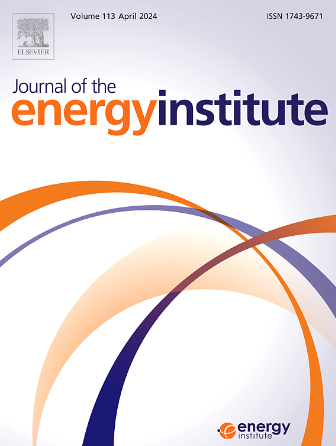Microscopic insights into the methanol oxidation mechanism in high-temperature supercritical water
IF 6.2
2区 工程技术
Q2 ENERGY & FUELS
引用次数: 0
Abstract
Although the methanol oxidation process in supercritical water has been studied in some previous experiments, the methanol oxidation rate is sensitive to the supercritical water concentration, and its influence on the methanol oxidation mechanism remains unclear. Moreover, while the presence of formic acid intermediate (HCOOH) has been reported, its detailed conversion pathways are still poorly understood, and experimental detection of such transient intermediates is difficult. To address the above shortcomings, this study employed reactive molecular dynamics simulations to explore the effects of supercritical water and oxygen concentrations on the methanol oxidation mechanism at the microscale, focusing on the conversion pathways of formic acid. The reaction rate constants and activation energies for the initial methanol oxidation were calculated using first-order kinetics theory to validate the accuracy of the CHO-S22 force field used. Adding supercritical water could decrease the activation energy of initial methanol oxidation and increase the reactivity. The evolution of various species under different ambient conditions was discussed. The results suggested that increasing water concentration could promote OH/H2 production, enhance formaldehyde intermediate consumption, and inhibit CO production. The main methanol oxidation pathways were analyzed in detail. The simulations captured another important methanol supercritical water oxidation route involving formic acid: CH3OH → CH2OH/CH3O → CH2O → HCOOH → HCOO→ CO2. Formic acid can be further oxidized to HCOO/COOH, but HCOO is predominant. HCOO was converted to CO2 mainly by pyrolysis and reacting with OH, while COOH can be interconverted with CO. The reactions of formic acid, HCOO/COOH, HCO, and CO intermediates with OH were enhanced with increasing water concentration under stoichiometric conditions. Increasing oxygen concentration could promote the conversion of methanol to formaldehyde via O2 and HO2 but may inhibit the conversion of formic acid through OH radicals to HCOO/COOH. This study provides new insights into the reaction network of methanol oxidation in supercritical water from a microcosmic perspective.
高温超临界水中甲醇氧化机理的微观研究
虽然已有一些实验研究了超临界水中甲醇氧化过程,但甲醇氧化速率对超临界水浓度敏感,其对甲醇氧化机理的影响尚不清楚。此外,虽然已经报道了甲酸中间体(HCOOH)的存在,但其详细的转化途径仍然知之甚少,并且这种瞬态中间体的实验检测很困难。针对上述不足,本研究采用反应分子动力学模拟的方法,探讨了超临界水和氧浓度对微观尺度甲醇氧化机理的影响,重点研究了甲酸的转化途径。利用一级动力学理论计算了甲醇初始氧化的反应速率常数和活化能,验证了CHO-S22力场的准确性。加入超临界水可以降低甲醇初始氧化活化能,提高反应活性。讨论了不同环境条件下不同物种的进化。结果表明,增加水浓度可以促进OH/H2生成,增加甲醛中间体消耗,抑制CO生成。详细分析了甲醇氧化的主要途径。模拟还捕获了另一条涉及甲酸的甲醇超临界水氧化路线:CH3OH→CH2OH/ ch30→CH2O→HCOOH→HCOO→CO2。甲酸可以进一步氧化为HCOO/COOH,但以HCOO为主。在化学计量条件下,甲酸、HCOO/COOH、HCO、CO中间体与OH的反应随着水浓度的增加而增强。增加氧浓度可以促进甲醇通过O2和HO2转化为甲醛,但可能抑制甲酸通过OH自由基转化为HCOO/COOH。本研究从微观角度对超临界水中甲醇氧化反应网络提供了新的认识。
本文章由计算机程序翻译,如有差异,请以英文原文为准。
求助全文
约1分钟内获得全文
求助全文
来源期刊

Journal of The Energy Institute
工程技术-能源与燃料
CiteScore
10.60
自引率
5.30%
发文量
166
审稿时长
16 days
期刊介绍:
The Journal of the Energy Institute provides peer reviewed coverage of original high quality research on energy, engineering and technology.The coverage is broad and the main areas of interest include:
Combustion engineering and associated technologies; process heating; power generation; engines and propulsion; emissions and environmental pollution control; clean coal technologies; carbon abatement technologies
Emissions and environmental pollution control; safety and hazards;
Clean coal technologies; carbon abatement technologies, including carbon capture and storage, CCS;
Petroleum engineering and fuel quality, including storage and transport
Alternative energy sources; biomass utilisation and biomass conversion technologies; energy from waste, incineration and recycling
Energy conversion, energy recovery and energy efficiency; space heating, fuel cells, heat pumps and cooling systems
Energy storage
The journal''s coverage reflects changes in energy technology that result from the transition to more efficient energy production and end use together with reduced carbon emission.
 求助内容:
求助内容: 应助结果提醒方式:
应助结果提醒方式:


